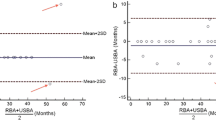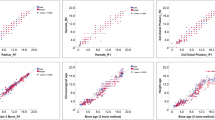Abstract
One hundred radiographs of the left hand and wrist from 40 children with chronic renal insufficiency or end-stage renal disease were examined to determine which method of bone age estimation provided the most useful information in these children. The Tanner and Whitehouse method showed better repeatability than the Greulich and Pyle atlas or the Buckler handbook when a sample of the radiographs were assessed twice by the same observer. The Tanner and Witehouse 20 (TW20) bone age showed less inter-observer bias than the radius, ulna and short bone age or the carpal bone age when three observers independently assessed the same sample of radiographs. TW20 was the most useful method of bone age assessment in this study of British children. An unexpected finding was that the carpal bones were significantly more retarded than the radius, ulna and short bones. Separate assessment of the carpal bone age may provide extra information of clinical relevance.
Similar content being viewed by others
References
Betts PR, White RHR (1976) Growth potential and skeletal maturity in children with chronic renal insufficiency. Nephron 16: 325–332
Greulich WW, Pyle SI (1959) Radiographic atlas of skeletal development of the hand and wrist, 2nd edn. Stanford University Press, Stanford
Tanner JM, Whitehouse RH, Cameron N, Marshall WA, Healy MJR, Goldstein H (1983) Assessment of skeletal maturity and prediction of adult height (TW2 Method). Academic Press, London
Buckler JMH (1979) A reference manual of growth and development. Blackwell, Oxford
Buckler JMH (1977) Comparison of systems of estimating skeletal age. Arch Dis Child 52: 667
Tanner JM (1962) Growth at adolescence, 2nd edn. Blackwell, Oxford
Cameron N (1984) Measurement of human growth. Croom Helm, Beckenham
Bowers GN, McComb RB (1975) Measurement of total alkaline phosphatase activity in human plasma. Clin Chem 21: 1988–1995
Tanner JM, Whitehouse RH (1976) Clinical longitudinal standards for height, weight, height velocity, weight velocity and the stages of puberty. Arch Dis Child 51: 170
Round JM (1973) Plasma calcium magnesium phosphorus and alkaline phosphatase levels in normal British school-children. Br Med J 3: 137–140
Fine RN, Gruskin AB (eds) (1984) End-stage renal failure in children. Saunders, Philadelphia
Gilli G, Mehls O, Wallstein B, Schärer K (1983) Prediction of adult height in children with chronic renal insufficiency. Kidney Int 24 [Suppl 15]: S48-S52
Fine RN, Malakzedah MH, Pennisi AJ, Ettenger RB, Uittenbugaart CH, Negrete RN, Korsch BM (1978) Long term results of renal transplantation in children. Pediatrics 61: 641–650
Mehls O, Ritz E, Kreusser W, Krempien E (1980) Renal osteodystrophy in uraemic children. Clin Endocrinol Metab 9: 151–172
Author information
Authors and Affiliations
Rights and permissions
About this article
Cite this article
Cundall, D.B., Brocklebank, J.T. & Buckler, J.M.H. Which bone age in chronic renal insufficiency and end-stage renal disease?. Pediatr Nephrol 2, 200–204 (1988). https://doi.org/10.1007/BF00862591
Received:
Revised:
Accepted:
Issue Date:
DOI: https://doi.org/10.1007/BF00862591




